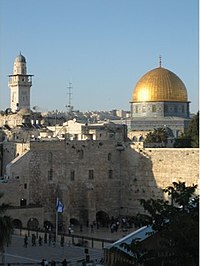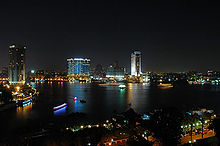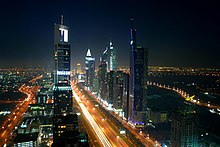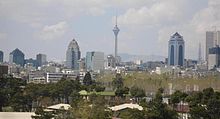Middle East: Difference between revisions
m →Regions |
|||
| Line 407: | Line 407: | ||
* Anatolia - [[Turkey]] |
* Anatolia - [[Turkey]] |
||
* Transcaucasia - [[Armenia]] and [[Azerbaijan]] |
* Transcaucasia - [[Armenia]] and [[Azerbaijan]] |
||
* The [[Levant]] - [[Jordan]], [[Lebanon]], [[Syria]], [[Palestinian National Authority| |
* The [[Levant]] - [[Jordan]], [[Lebanon]], [[Syria]], [[Palestinian National Authority|Palestinian Authority]] and [[Israel]] |
||
* The [[Northern Africa]] - [[Algeria]], [[Egypt]], [[Libya]], [[Morocco]], [[Tunisia]] |
* The [[Northern Africa]] - [[Algeria]], [[Egypt]], [[Libya]], [[Morocco]], [[Tunisia]] |
||
Revision as of 18:05, 13 February 2008

The Middle East is a historical and political region of Afro-Eurasia with no clear boundaries. The term "Middle East" was popularized around 1900 in Britain; it has a loose definition traditionally encompassing countries or regions in Western Asia and parts of North Africa. The corresponding adjective to Middle East is Middle-Eastern and the derived noun is Middle-Easterner.
The history of the Middle East dates back to ancient times, and throughout its history the Middle East has been a major center of world affairs. The Middle East is also the geographic origin of three of the world’s great religions - Christianity, Islam, Judaism. The Middle East generally has an arid and hot climate, with several major rivers providing for irrigation to support agriculture in limited areas. Many countries located around the Persian Gulf have large quantities of crude oil. In modern times, the Middle East remains a strategically, economically, politically, culturally, and religiously sensitive region.
Etymology
The term "Middle East" may have originated in the 1850s in the British India Office,[1] and became more widely known when American naval strategist Alfred Thayer Mahan used the term.[2] During this time the British and Russian Empires were vying for influence in Central Asia, a rivalry which would become known as The Great Game. Mahan realized not only the strategic importance of the region, but also of its center, the Persian Gulf.[3][4] He labeled the area surrounding the Persian Gulf as the Middle East, and said that after the Suez Canal, it was the most important passage for Britain to control in order to keep the Russians from advancing towards India.[5] Mahan first used the term in his article "The Persian Gulf and International Relations," published in September 1902 in the National Review, a British journal.
The Middle East, if I may adopt a term which I have not seen, will some day need its Malta, as well as its Gibraltar; it does not follow that either will be in the Persian Gulf. Naval force has the quality of mobility which carries with it the privilege of temporary absences; but it needs to find on every scene of operation established bases of refit, of supply, and in case of disaster, of security. The British Navy should have the facility to concentrate in force if occasion arise, about Aden, India, and the Persian Gulf.[6]
Mahan's article was reprinted in The Times and followed in October by a 20 article series entitled "The Middle Eastern Question," written by Sir Ignatius Valentine Chirol. During this series, Chirol expanded the definition of the "Middle East" to include "those regions of Asia which extend to the borders of India or command the approaches to India."[7] With the series end in 1903, The Times removed quotation marks from subsequent uses of the term.[8]
Until World War II, it was customary to refer to areas centered around Turkey and the eastern shore of the Mediterranean as the "Near East," while the "Far East" centered on China.[9] The Middle East then meant the area from Mesopotamia to Burma, namely the area between the Near East and the Far East. The sense described in this article evolved during the war, perhaps influenced by the ancient idea of the Mediterranean as the "sea in the middle".
One widely used definition of the "Middle East" is that of the airline industry, maintained by the IATA standards organization. This definition — as of early 2007 — includes Bahrain, Egypt, Iran, Iraq, Israel, Jordan, Kuwait, Lebanon, Palestinian territories, Oman, Qatar, Saudi Arabia, Sudan, Syrian Arab Republic, United Arab Emirates, and Yemen.[10] This definition is used in world-wide airfare and tax calculations for passengers and cargo.
Criticism and usage
Many have criticized the term Middle East for what they see as Eurocentrism,[11][12] because it was originally used by Europeans (although Mahan was American) and reflects the geographical position of the region from a European perspective. It is also criticized due to the fact that the term today is often used to only refer to the Arab world, making the situation more confused.
Today the term is used by Europeans and non-Europeans alike, unlike the similar term Mashreq, used exclusively in Arabic-language contexts. The region is only east from the perspective of Europe. To an Indian, it lies to the west; to a Russian, it lies to the south. The description Middle has also led to some confusion over changing definitions. Before the First World War, "Near East" was used in English to refer to the Balkans and the Ottoman Empire, while "Middle East" referred to Persia, Kurdistan, Afghanistan, present-day Pakistan and Central Asia, Turkestan, and the Caucasus. In contrast, "Far East" referred to the countries of East Asia (e.g. China, Japan, Korea, Hong Kong, Taiwan, etc.). Such critics usually advise using an alternative term, such as "Western Asia." The official UN designation of the area is "Western Asia."
With the disappearance of the Ottoman Empire in 1918, "Near East" largely fell out of common use in English, while "Middle East" came to be applied to the re-emerging countries of the Islamic world. However, the usage of "Near East" was retained by a variety of academic disciplines, including archaeology and ancient history, where it describes an area identical to the term Middle East, which is not used by these disciplines (see Ancient Near East).
The Eisenhower Doctrine, a 1957 foreign policy of the United States government, was the first to officially use the term Middle East.[9] Secretary of State John Foster Dulles defined the Middle East as "the area lying between and including Libya on the west and Pakistan on the east and Turkey on the North and the Arabian peninsula to the south, plus the Sudan and Ethiopia."[9] In 1958, the State Department explained that the terms "Near East" and "Middle East" were interchangeable, and defined the region as including only Egypt, Syria, Israel, Lebanon, Jordan, Iraq, Saudi Arabia, Kuwait, Bahrain, and Qatar.[13]
The Associated Press Stylebook says that Near East formerly referred to the farther west countries while Middle East referred to the eastern ones, but that now they are synonymous. It instructs:
Use Middle East unless Near East is used by a source in a story. Mideast is also acceptable, but Middle East is preferred.[14]
At the United Nations, the numerous documents and resolutions about the Middle East are in fact concerned with the Arab-Israeli conflict, in particular the Israeli-Palestinian conflict, and, therefore, with the four states of the Levant. The term Near East is occasionally heard at the UN when referring to this region.
Translations
There are terms similar to "Near East" and "Middle East" in other European languages, but since it is a relative description, the meanings depend on the country and are different from the English terms generally. In German the term "Naher Osten" (Near East) is still in common use (although nowadays the term "Mittlerer Osten" is more and more common) and in Russian Ближний Восток or "Blizhniy Vostok" (Near East), Bulgarian Близкия Изток (Near East) or Polish Bliski Wschód remains as the only appropriate term for the region. However, some languages do have "Middle East" equivalents, such as the French Moyen-Orient and the Italian Medio Oriente.
Perhaps due to the influence of the Western press, the Arabic equivalent of “Middle East,” “الشرق الأوسط” (“a-sharq-l-’awsat”), has become standard usage in the mainstream Arabic press, comprehending the same meaning as the term “Middle East” in North American and Western European usage. The Persian equivalent for Middle East is خاورمیانه (Khāvarmiyāneh).
History



The Middle East lies at the juncture of Eurasia and Africa and of the Mediterranean Sea and the Indian Ocean. It is the birthplace and spiritual center of the Christianity, Islam, Judaism, Yezidi, and in Iran, Mithraism, Zoroastrianism, Manichaeism, and the Bahá'í Faith. Throughout its history the Middle East has been a major center of world affairs; a strategically, economically, politically, culturally, and religiously sensitive area.
The earliest civilizations, Mesopotamia and Egypt, originated in the Fertile Crescent and Nile Valley regions of the ancient Near East, as well as the civilizations of the Levant, Persia, and Arabia. The Middle East region was first unified under the Achaemenid Empire followed later by the Macedonian Empire. It would be the Arab Caliphates of the Middle Ages, however, that would first unify the Middle East as a distinct region and create the dominant ethnic identity that persists today. The Seljuk Empire would also later dominate the region..
The modern Middle East began after World War I, when the Ottoman Empire, which was allied with the defeated Central Powers, was partitioned into a number of separate nations. Other defining events in this transformation included the establishment of Israel in 1948 and the departure of European powers, notably Britain and France. They were supplanted in some part by the rising influence of the United States.
In the 20th century, the region's significant stocks of crude oil gave it new strategic and economic importance. Mass production of oil began around 1945, with Saudi Arabia, Iran, Kuwait, Iraq, and the United Arab Emirates having large quantities of oil.[15] Estimated oil reserves, especially in Saudi Arabia and Iran, are some of the highest in the world, and the international oil cartel OPEC is dominated by Middle Eastern countries.
During the Cold War, the Middle East was a theater of ideological struggle between the two superpowers: the United States and the Soviet Union, as they competed to influence regional allies. Within this contextual framework, the United States sought to divert the Arab world from Soviet influence. Throughout the 20th and into the 21st century, the region has experienced both periods of relative peace and tolerance and periods of conflict and war. Current issues include the Iraq War, Israeli-Palestinian conflict, and the Iranian nuclear program.
Geography
The Middle East defines a geographical area, but does not have precise defined borders. The modern definition of the region includes: Bahrain, Egypt, Iran, Iraq, Israel, Jordan, Kuwait, Lebanon, Oman, the Palestinian territories, Qatar, Saudi Arabia, Syria, Turkey, the United Arab Emirates, and Yemen. Egypt, with its Sinai Peninsula in Asia, is considered part of the Middle East, although most of the country lies geographically in North Africa. According to international media, North African nations without Asian links, such as Libya, Tunisia and Algeria, are increasingly being called North African.
The Middle East is primarily arid and semi-arid consisting of grasslands, rangelands, and deserts.[16]. Water shortages are a problem in many parts of the Middle East, with rapidly growing populations increasing demands for water, while salinization and pollution threaten water supplies.[16] Major rivers, including the Nile and the Euphrates, provide sources for irrigation water to support agriculture.

Topography
While Middle East mainly contains areas with low relief, portions of Turkey, Iran, and Yemen include mountainous terrain. The Anatolian Plateau is sandwiched between the Pontus Mountains and Taurus Mountains in Turkey. Mount Ararat in Turkey rises to 5,165 meters and Mount Damavand, located in Iran's Elburz Mountains rises to 5,610 meters and is the highest peak in the middle East.[17] The Zagros Mountains are located in Iran, in areas along its border with Iraq. The Central Plateau of Iran is divided into two drainage basins. The northern basin is Dasht-e Kavir (Great Salt Desert), and Dasht-e-Lut is the southern basin.
In Yemen, elevations exceed 3,700 meters in many areas, and highland areas extend north along the Red Sea coast and north into Lebanon. A fault-zone also exists along the Red Sea, with continental rifting creating trough-like topography with areas located well-below sea level.[18] The Dead Sea, located on the border between the West Bank, Israel, and Jordan, is situated at 418 m (1371 ft) below sea level, making it the lowest point on the surface of the Earth.[19]
A large lowland belt is located on the Arabian Peninsula, from central Iraq, through Saudi Arabia, and to Oman and the Arabian Sea. The Euphrates and Tigris rivers cut through the lowland belt in Iraq and flow into the Persian Gulf. Rub'al KhāLī, one of the world's largest sand deserts, spans the southern third of the Arabian Peninsula in Saudi Arabia, parts of Oman, the United Arab Emirates and Yemen. Jebel al Akhdar is a small range of mountains located in northeastern Oman, bordering the Gulf of Oman.
Geology

Three major tectonic plates converge on the Middle East, including the African, Eurasian, and Arabian plates. The boundaries between the tectonic plates make up the Azores-Gibraltar Ridge, extending across North Africa, the Red Sea, and into Iran.[20] The Arabian Plate is moving northward into the Anatolian plate (Turkey) at the East Anatolian Fault,[21] and the boundary between the Aegean and Anatolian plate in eastern Turkey is also seismically active.[20]
Water resources
Several major aquifers provide water to large portions of the Middle East. In Saudi Arabia, two large aquifers of Palaeozoic and Triassic origins are located beneath the Jabal Tuwayq mountains and areas west to the Red Sea.[22] Cretaceous and Eocene-origin aquifers are located beneath large portions of central and eastern Saudi Arabia, including Wasia and Biyadh which contain amounts of both fresh water and saline water.[22] The Nubian aquifer system underlies large areas of North Africa.[22] The Great Manmade River project in Libya utilizes an extensive network of pipelines to transport water from the Nubian aquifer to its population centers. Recharge for these deep rock aquifers is on the order of thousands of years, thus the aquifers are essentially non-renewable resources.[23] Flood or furrow irrigation, as well as sprinkler methods, are extensively used for irrigation, covering nearly 90,000 km² across the Middle East for agriculture.[24]
Territories and regions
1 Under Israeli law. The UN doesn't recognize Jerusalem as Israel's capital.
2 Includes the whole of the West Bank, according to the pre-1967 boundaries.
3 In addition, there are around 400,000 Israeli settlers in the West Bank, of which half are in East-Jerusalem.
Source:
- The World Factbook, United States Central Intelligence Agency (CIA), 14 November 2006. [1]
Demographics
Ethnic groups

The Middle East is home to numerous ethnic groups, including Arabs, Turks, Persians, Jews, Armenians, Georgians, Egyptians, Kurds, Greeks, Assyrians, Azeris, Circassians, Berbers, Nubians, Samaritans, and Turkmens.
Religions
The Middle East is very diverse when it comes to religions, most of which originated there. Islam in its many forms is by far the largest religion in the Middle East, but other faiths, such as Judaism and Christianity, are also important. There are also important minority religions like Bahá'í, Druze, Yazdanism, and Zoroastrianism.
Languages
Languages of the Middle East span many different families, including Indo-European, Afro-Asiatic, and Altaic.
Arabic in its numerous varieties and Persian are most widely spoken in the region, with Arabic being the most widely spoken language in the Arab countries. Other languages spoken in the region include Armenian, Syriac (a form of Aramaic), Azeri, , Berber languages, Circassian, Persian, , Georgian, Gilaki language and Mazandarani languages, Hebrew in its numerous varieties, Kurdish, Luri, Turkish and other Turkic languages, Greek. In Turkey, Kurdish, Dimli (or Zaza), Azeri, Kabardian, and Gagauz languages are spoken, in addition to the Turkish language.
English is also spoken, especially among the middle and upper class, in countries such as Egypt, Jordan, Israel, Iraq and Kuwait.[25][26] French is spoken in Algeria, Israel, Lebanon, Morocco, Syria, and Egypt. Urdu and other South Asian languages are spoken in many Middle Eastern countries, such as the United Arab Emirates, Israel, and Qatar, which have large numbers of South Asian immigrants. The largest Romanian-speaking community in the Middle East is found in Israel, where as of 1995 Romanian is spoken by 5% of the population.[27][28] Romanian is spoken mostly as a secondary language by people from Arab-speaking countries that made their studies in Romania. It is estimated that almost half a million Middle Eastern Arabs studied in Romania during the 1980s.[29] Russian language is also spoken by a large portion of the Israeli population, due to emigration in the late 1990s.
Economy





Middle Eastern economies range from nations being very poor (such as Yemen) to extremely wealthy nations (such as UAE and Saudi Arabia). Overall, as of 2007, according to CIA world factbook, all nations in the Middle East are maintaining a positive rate of growth.
The 2 largest Middle Eastern economies, according to CIA world factbook 2007, in terms of PPP are (in rank) are Turkey ($ 640,400,000,000), Iran ($ 599,200,000,000). When it comes to per capita (PPP) based income, the 3 top countries are UAE at the top ($49,700) followed by Qatar ($29,800), and then comes Kuwait ($23,100). The two lowest ranking countries in the Middle East, in terms of per capita income (PPP) Yemen ($ 1000 as of 2006), and Iraq ($ 1900 as of 2006).
The economic structure of Middle Eastern nations are different in the sense that while some nations are heavily dependent on export of only oil and oil related products (Saudi Arabia, UAE, and Kuwait), others have a highly diverse economic base (Turkey and Egypt). Industries of the Middle Eastern region includes oil and oil related products, agriculture, cotton, cattle, dairy, textiles, leather products, surgical instruments, defence equipment (guns, ammunition, Tanks, submarines, fighter jets, UAVs, and missiles). Banking is also an important sector of the economies especially in the case of UAE, and Bahrain. Tourism, with exception to Turkey and Egypt, remains largely unexplored and under developed due to the conservative nature of the region as well as due to political turmoil in certain regions of Middle East. In recent years, however, countries such as UAE, Bahrain, and Jordan have begun experiencing greater number of tourists due to improving tourist facilities and relaxing of tourism related policies.
This section needs expansion. You can help by adding to itadding to it or making an edit request. |
Regions
- Iranian Plateau - Iran, Afghanistan and Pakistan
- Arabian Peninsula - Saudi Arabia, Kuwait, Qatar, U.A.E., Oman, Yemen and Bahrain
- Mesopotamian region - Iraq
- Anatolia - Turkey
- Transcaucasia - Armenia and Azerbaijan
- The Levant - Jordan, Lebanon, Syria, Palestinian Authority and Israel
- The Northern Africa - Algeria, Egypt, Libya, Morocco, Tunisia
See also
- Fertile Crescent
- Greater Middle East
- History of the Middle East
- List of conflicts in the Middle East
- Middle East Institute
- Middle East Studies Association of North America
- Maayan Middle East poetry magazine
- Near East
- Central Asia
- Orientalism
- Western Asia
- Timeline of Middle Eastern History
References
- ^ Beaumont, Peter , Gerald H. Blake, J. Malcolm Wagstaff (1988). The Middle East: A Geographical Study. David Fulton. pp. p.16.
{{cite book}}:|pages=has extra text (help)CS1 maint: multiple names: authors list (link) - ^ Koppes, C.R. (1976). "Captain Mahan, General Gordon and the origin of the term "Middle East"". Middle East Studies. 12: p. 95-98.
{{cite journal}}:|pages=has extra text (help) - ^ Melman, Billie. The Cambridge Companion to Travel Writing: 6 The Middle East / Arabia, Cambridge Collections Online. Retrieved January 8, 2006.
- ^ Palmer, Michael A. Guardians of the Persian Gulf: A History of America's Expanding Role in the Persian Gulf, 1833-1992. New York: The Free Press, 1992. ISBN 0-02-923843-9 p. 12-13.
- ^ Laciner, Dr. Sedat. "Is There a Place Called ‘the Middle East’?", The Journal of Turkish Weekly]", June 2, 2006. Retrieved January 10, 2007.
- ^ Adelson, Roger. London and the Invention of the Middle East: Money, Power, and War, 1902-1922. New Haven: Yale University Press, 1995. ISBN 0-300-06094-7 p. 22-23
- ^ Adelson, 24.
- ^ Adelson, 26.
- ^ a b c Davison, Roderic H. (1960). "Where is the Middle East?". Foreign Affairs. 38: p. 665-675.
{{cite journal}}:|pages=has extra text (help) - ^ Middle East, IATA. Retrieved August 3, 2007.
- ^ Shohat, Ella. "Redrawing American Cartographies of Asia". City University of New York. Retrieved 2007-01-12.
- ^ Hanafi, Hassan. "The Middle East, in whose world?". Nordic Society for Middle Eastern Studies. Retrieved 2007-01-12.
- ^ "'Near East' is Mideast, Washington Explains". The New York Times. August 14, 1958.
- ^ Goldstein, Norm. The Associated Press Stylebook and Briefing on Media Law. New York: Basic Books, 2004. ISBN 0465004881 p. 156
- ^ Goldschmidt Jr., Arthur (1999). A Concise History of the Middle East. Westview Press. pp. p.8.
{{cite book}}:|pages=has extra text (help) - ^ a b "Chapter 7: Middle East and Arid Asia". IPCC Special Report on The Regional Impacts of Climate Change: An Assessment of Vulnerability. Intergovernmental Panel on Climate Change (IPCC). 1997.
- ^ Beaumont, Peter, Gerald H. Blake, J. Malcolm Wagstaff (1988). The Middle East: A Geographical Study. David Fulton. pp. p. 19.
{{cite book}}:|pages=has extra text (help)CS1 maint: multiple names: authors list (link) - ^ Sweeney, Jerry J., William R. Walter. "Preliminary Definition of Geophysical Regions for the Middle East and North Africa" (PDF). Lawrence Livermore National Laboratory.
{{cite web}}: CS1 maint: multiple names: authors list (link) - ^ "ASTER Image Gallery: The Dead Sea". NASA.
- ^ a b Beaumont, Peter, Gerald H. Blake, J. Malcolm Wagstaff (1988). The Middle East: A Geographical Study. David Fulton. pp. p. 22.
{{cite book}}:|pages=has extra text (help)CS1 maint: multiple names: authors list (link) - ^ Muehlberger, Bill. "The Arabian Plate". NASA, Johnson Space Center.
- ^ a b c Beaumont, Peter, Gerald H. Blake, J. Malcolm Wagstaff (1988). The Middle East: A Geographical Study. David Fulton. pp. p. 86.
{{cite book}}:|pages=has extra text (help)CS1 maint: multiple names: authors list (link) - ^ Beaumont, Peter, Gerald H. Blake, J. Malcolm Wagstaff (1988). The Middle East: A Geographical Study. David Fulton. pp. p. 85.
{{cite book}}:|pages=has extra text (help)CS1 maint: multiple names: authors list (link) - ^ "Food and Agriculture Organization (FAO)".
- ^ "World Factbook - Jordan".
- ^ "World Factbook - Kuwait".
- ^ According to the 1993 Statistical Abstract of Israel there were 250,000 Romanian speakers in Israel, at a population of 5,548,523 (census 1995).
- ^ Reports of about 300,000 Jews that left the country after WW2
- ^ Evenimentul Zilei
Further reading
Anderson, R., Seibert, R., & Wagner, J. Politics and Change in the Middle East, 8th Ed. (N.J.: Prentice-Hall, 2006).
External links
- "Middle East" - Council on Foreign Relations: "A Resource for Nonpartisan Research and Analysis"
- Middle East Department University of Chicago Library
- Middle East Economic Digest: "The leading information source on business in the Middle East" - magazine website
- Middle East News from Yahoo! News
- Template:Dmoz
- Middle East Live News
- Middle East Business, Financial & Industry News — ArabianBusiness.com






